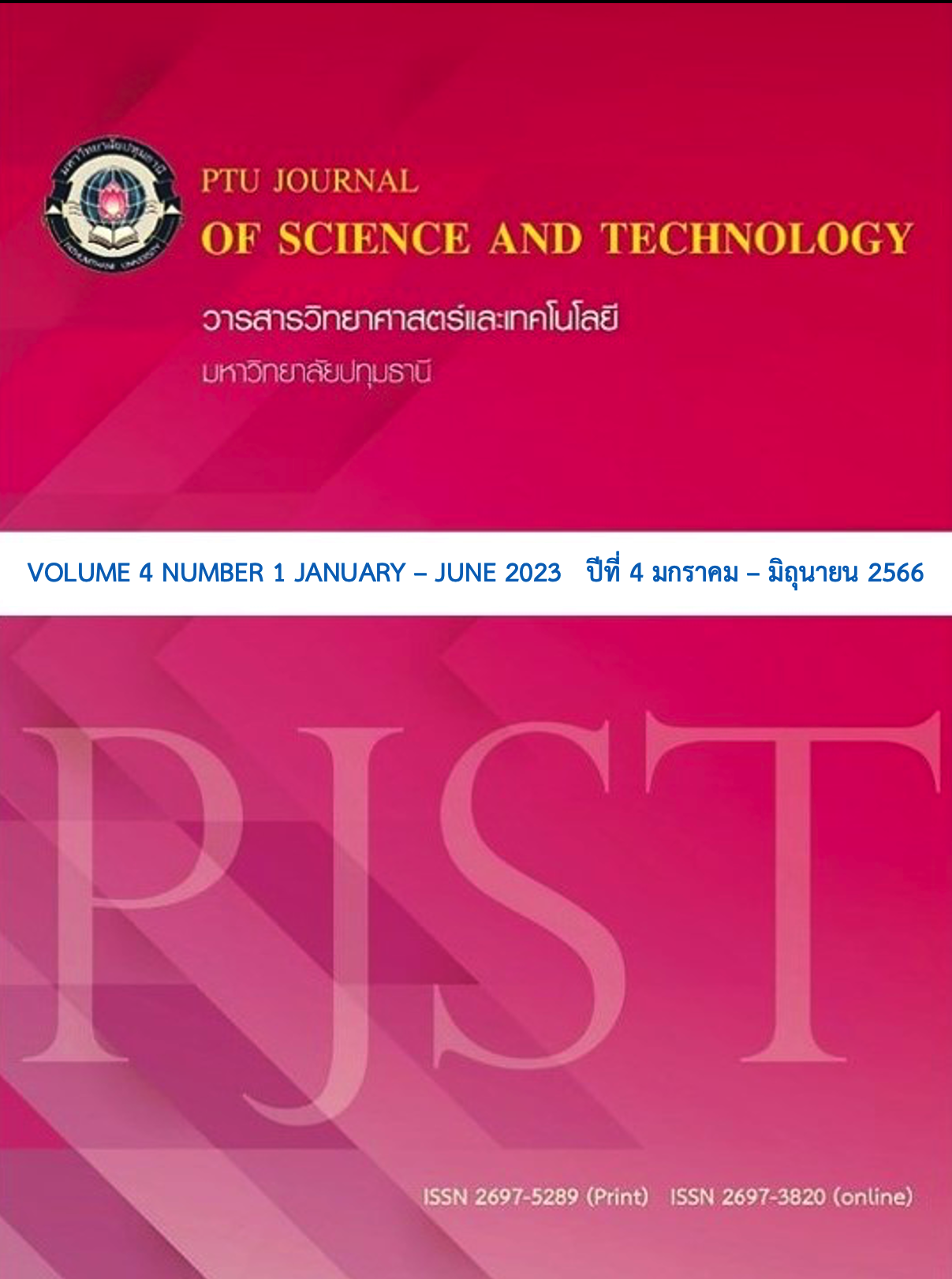การศึกษารูปแบบหลอดเลือดดำบริเวณท้องแขนในประชากรไทย โดยใช้เครื่องถ่ายภาพภายใต้แสงอินฟราเรดชนิดคลื่นสั้น ด้วยเทคนิคประมวลผลภาพ
Main Article Content
บทคัดย่อ
รูปแบบของหลอดเลือดดำบริเวณท้องแขนมีความแปรปรวนในแต่ละบุคคล ที่พบได้บ่อยเมื่อมีการวินิจฉัยหรือตรวจด้วยตาเปล่าคือการขาดหายไปของหลอดเลือดดำ median cubital vein ซึ่งเป็นหลอดเลือดเส้นที่นิยมใช้ในการทำหัตถการทางการแพทย์ กรณีที่บุคลากรทางการแพทย์ขาดประสบการณ์หรือขาดความเข้าใจรูปแบบของหลอดเลือดดำบริเวณนี้ อาจจะทำให้ผู้ป่วยมีความเสี่ยงและเกิดอันตรายขึ้นได้ ในงานวิจัยนี้มีวัตถุประสงค์นำเสนอวิธีการจำแนกรูปแบบของหลอดเลือดดำ โดยใช้เครื่องถ่ายภาพหลอดเลือดดำภายใต้แสงอินฟราเรดชนิดคลื่นสั้น ด้วยเทคนิคประมวลผลภาพ ข้อมูลภาพเส้นเลือดที่ได้ แบ่งพื้นที่เป็น 6 ส่วน และคำนวณหาผลต่างพื้นที่ที่มีข้อมูลหลอดเลือดดำรวม เพื่อใช้เป็นเกณฑ์ในการจำแนกรูปแบบของหลอดเลือดดำ จากอาสาสมัครชาวไทยจำนวน 150 คน ที่มีสุขภาพแข็งแรงและไม่มีความผิดปกติที่แขนทั้งสองข้าง ทำการถ่ายภาพของหลอดเลือดที่ท้องแขน จำแนกแบ่งเป็นแขนข้างขวา 138 แขน และแขนข้างซ้าย 112 แขน ผลของงานวิจัยนี้พบว่าสามารถจำแนกรูปแบบของหลอดเลือดดำของอาสาสมัครได้ 4 รูปแบบ โดยรูปแบบหลอดเลือดดำที่พบในอาสาสมัครชาวไทยมากที่สุด คือ รูปแบบที่ 3 (83 แขน 33.2 %) ในระหว่างแขนขวาและแขนซ้าย รูปแบบที่พบได้บ่อยมีความแตกต่างกัน โดยที่แขนซ้ายจะพบรูปแบบที่ 1 ได้มากกว่าในแขนขวา มีอาสาสมัครเพียง 37 คน ที่พบว่ามีรูปแบบของหลอดเลือดดำในแขนทั้งสองข้างเป็นรูปแบบเดียวกัน จากผลการทดลองจำแนกรูปแบบของเส้นเลือดดำจากระบบที่พัฒนาขึ้นมาเปรียบเทียบกับการจำแนกรูปแบบของเส้นเลือดดำโดยผู้เชี่ยวชาญพบว่ามีค่าความคลาดเคลื่อนอยู่ที่ 1.4% ซึ่งเป็นค่าที่สามารถยอมรับได้ ดังนั้นจึงสรุปได้ว่าวิธีการที่ได้นำเสนอขึ้นมานั้นสามารถจำแนกรูปแบบของเส้นเลือดดำได้อย่างเหมาะสม
Article Details

อนุญาตภายใต้เงื่อนไข Creative Commons Attribution-NonCommercial-NoDerivatives 4.0 International License.
ความคิดเห็นและข้อเสนอแนะใดๆ ที่นำเสนอในบทความเป็นของผู้เขียนแต่เพียงผู้เดียว โดยบรรณาธิการ กองบรรณาธิการ และคณะกรรมการวารสารวิทยาศาสตร์และเทคโนโลยี มหาวิทยาลัยปทุมธานี ไม่ได้มีส่วนเกี่ยวข้องแต่อย่างใด มหาวิทยาลัย บรรณาธิการ และกองบรรณาธิการจะไม่รับผิดชอบต่อข้อผิดพลาดหรือผลที่เกิดจากการใช้ข้อมูลที่ปรากฏในวารสารฉบับนี้
เอกสารอ้างอิง
Nocross WA, Shhackford SR. (1988, Aug). “Arteriovenous fistula: apotential complication of Venipuncture”. Arch Intern Med; 148: 1815-6
Golmohammadi Mohammad Ghasem, et al. (2021). “Variation of superficial veins of cubital fossa among students of ardabil University of Medical Sciences”. Translational Research in Anatomy, V.25, 100136.
Vasuda T.A., (2013) “study on superficial veins of upper limb” NJCA, pp. 2: 204-8
Lima-Oliveira G, et al. (2017). “Patient posture for blood collection by venipuncture: recall for standardization after 28 years”. Rev Bras Hematol Hemoter. 39(2): p.127-132.
Septimiu Crisan, Bogdan Tebrean. (2017). “Low cost, high quality vein pattern recognition device with liveness Detection. Workflow and implementations”. Measurement 108: 207 -216
Kanae Mukai et al. (2020). “Safety of Venipuncture Sites at the Cubital Fossa as Assessed by Ultrasonography”. J Patient Saf. ; 16(1): 98–105.
Dharap AS, Shaharuddin MY. (1994). “Pattern of superficial veins of the cubital fossa in Malays”. Med J Malaysia: 49(3); 239-41
Ukoha UU, Oranusi CK, Okafor JI et al. (2013). “Pattern of superficial venous arrangement in the cubital fossa of adult Nigerians”. Niger J Clin Pract; 16: 104-9
AlBustami F, Altarawneh I, Rababah E. (2014). “Pattern of superficial venous arrangement in the cubital fossa of adult Jordanians”. Jordan Med. J; 48: 269-274.
Hyunsu Lee, Sang-Hoon Lee, et al. (2015, Mar). “Variations of the cubital superficial vein investigated by using the intravenous illuminator”. Anat cell Biol: 48(1); 62-65
Agthong S, Wiwanitkit V. (1998, Oct). “Synopsis of important veins variation, anomalies and clinical applications”. Chula Med; 42(10): 961-74
Fukuroku K, Narita Y, Taneda Y, Kobayashi S,Gayle A.A. (2016, May). “Does infrared visualization improve selection of venipuncture sites for indwelling needle at the forearm in second-year nursing students?”. Nurse Educ Pract; 18: 1-9
Gray, A. (1997) The Gaussian and Mean Curvatures. Modern Differential Geometry of Curves and Surfaces with Mathematica, 2nd ed. Boca Raton, FL: CRC Press, pp. 373-380.
Yaacob, Mohd Noorulfakhri & Syed Idrus, et al. (2020). Decision Making Process in Keystroke Dynamics. Journal of Physics: Conference Series. 1529.
Woodburne RT, Burkel WE, eds. (1994). Essentials of Human Anatomy.9th ed. New York: Oxford University Press.
Bekel A.A., (2018). “Anatomical variations of superficial veins pattern”. Anatomy Journal of Africa., pp. (2): 1238 – 1243.


